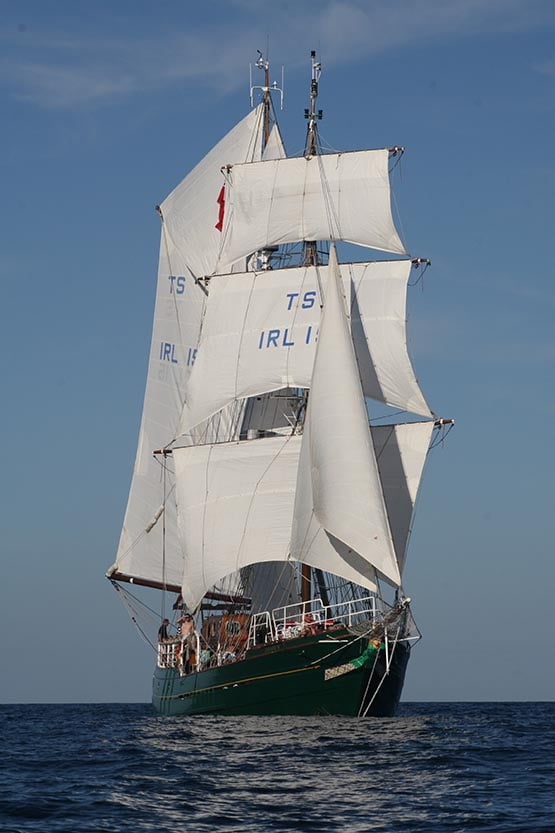Displaying items by tag: Atlantic Youth Trust
More Info On Next Month's Atlantic Youth Trust Conference
#TallShips - The Atlantic Youth Trust has revealed more details of its inaugural conference and gala dinner in Galway next month, as previously reported on Afloat.ie.
Designed as workshops with input from participants, the day's programme comprises three lively sessions commencing at 11.30am with a break for lunch and the Six Nations rugby match, and rolling into the evening's gala ball.
Session 1 is on 'Educating & Youth Development on the Ocean', a concept something obvious to those who have experienced it first hand yet hard to comprehend for those that haven't. The conference will hear from some of the island's most experience shore-based and ocean-based educators.
Session 2 from 3/30pm is on 'Vessel Design & Construction' - with an emphasis on how to design the best yacht or tall ship to be fit for purpose.
While the focus will be on the Atlantic Youth Trust's proposed new tall ship, the session will hear from a range of experts in traditional and modern design, and will also explore the Galway Hooker One Design concept.
Session 3 from 4.30pm is on the topic 'SeaFest 2016 & Hosting and Attracting Major Maritime Events'. Speakers will include some of the most experienced event managers of high-profile maritime events on the island of Ireland previewing SeaFest 2016 this July and discussing the development of related ideas informed by last year's inaugural event.
The day's events are aimed to attract a wide range of stakeholders and will conclude with the gala dinner.
To book your free place at the conference (lunch not provided) or to book a table or individual place at the dinner, visit the Atlantic Youth Trust website HERE. Special hotel rates are also available.
Atlantic Youth Trust Hosting Inaugural Gala In March
#TallShips - The Atlantic Youth Trust is set to host its inaugural conference and gala ball in Galway this March, as the Galway Independent reports.
The sail training tall ship project, which recently hailed its inclusion in the new implementation plan for the Stormont Agreement, will hold the event at the Galway Bay Hotel on Saturday 12 March – in the same city that's prepping a bid to attract the Tall Ships Races in 2019.
Besides hosting an evening of keynote speakers and an afternoon of workshops, the day is also intended to double as a fundraiser for a West of Ireland Bursary Fund for youth sail training along the lines of those already established in Drogheda and West Cork.
As previously reported on Afloat.ie, the Atlantic Youth Trust proposes the construction of a new tall ship to replace the Asgard II as a symbol of cross-border unity and a practical training vessel to teach adaptable skills for young people.
The Galway Independent has much more on the story HERE.
High Hopes for Ireland's Tall Ship – The Force is With Them
The governments in both jurisdictions in Ireland have included an all-Ireland sail training ship for the Atlantic Youth Trust in their long term capital expenditure proposals. And the movement in favour of support for this project has become so strong that the nationwide team involved in promoting it are confident that the ship’s future is now secured.
They continue to hold this view even with general elections and possible major changes in administrative direction taking place, north and south, within the next four months. Thus this week’s 2016 Annual General Meeting of the Atlantic Youth Trust in Irish Lights Headquarters in Dun Laoghaire found itself reviewing a remarkable year of progress and achievement, while giving pointers and reassurances for the successful way ahead. W M Nixon was there to take on board an evening of multiple messages.
It could well be that some time in the future, we will come to the sad but inescapable conclusion that the foundering of the Republic of Ireland’s national 84–ft sail training brigantine Asgard II in September 1908, followed within two years by the sinking of the Northern Ireland 70ft training ketch Lord Rank, were necessary disasters for the progress towards the ultimately more healthy ideal of a Class A 40-metre sail training barquentine.
The proposed ship - determinedly and enthusiastically serving all Ireland – will be initially funded through donations, and by government grants from both sides of the border. But the vessel is to be run independently by a cross-border trust rather than by some obscure unit of a government department.
September 2008 saw Ireland on the edge of the financial abyss. For a government under enormous pressure from all sides, a government, moreover, in which the minister responsible for the Asgard II took little or no interest in the ship and what she did, this sinking was a blessing in disguise.
The hull of Asgard II, completed in 1981, had long passed its sell-by date. When she sank, she took with her the magnificent rig which had been totally replaced only a couple of years earlier. Yet a properly involved government would surely have taken on board the advice that her timber hull urgently needed replacing, preferably with one built in steel. For although in 2008 the ship looked better than ever thanks to the devotion of her crew in working way over and above the call of duty in painting, varnishing and routine maintenance, there was no escaping the fact that the basic hull and its original fittings were living on borrowed time.
Ironically, the visit to La Rochelle, which she was nearing when she sank, included plans for a three-week stopover for a complete survey and some necessary repairs. Whether or not this would have revealed the fracturing seacock which many reckon to have caused the unstoppable ingress of water can only be a matter of speculation. The fact of the matter is the ship sank, and in an exemplary display of seamanship, the captain and crew ensured that their full quota of young trainees got safely away.

Flying the flag for Ireland – Asgard II in fine form, seen from another tall ship
But although Asgard II remained stubbornly intact and upright for some weeks on the Bay of Biscay seabed off Belle Ile, a government with financial Armageddon crashing down around its ears was glad enough to be shot of a unique project which some of them had never really understood or supported in the first place. Thus they refused to consider multiple suggests as to how best Asgard II could be salvaged. And frankly, it was for the best that they did so. For like it or not, while she was much-loved by the maritime community, the vessel had lost public confidence.
The subsequent loss of the Lord Rank in July 2010 after striking a rock likewise resulted in a merciful absence of casualties. But with Ireland north and south now in the utter depths of economic recession with no governmental enthusiasm whatsoever for non-essential projects, it was time to re-group for a few years and re-think the entire sail training ideal. It became almost an underground movement, with Coiste an Asgard being re-structured as Sail Training Ireland, and diligently setting about placing Irish trainees on the ships of other nations. It’s an ongoing programme which has been notably successful in providing both sea-going experience and a guaranteed international dimension for young people from all over Ireland, city and country alike.
Meanwhile there were rumblings from the west of Ireland where Enda O'Coineen and John Killeen were building on the can-do attitude of Galway, and from this there gradually emerged the Atlantic Youth Trust. It’s a determinedly all-Ireland group in which the Chairman is former Winter Olympics Gold Medallist Lord Glentoran from Northern Ireland, with the unstoppable unsinkable O Coineen as President. Supporting them is one very impressive list of seriously heavy hitters in the maritime and big business sphere from all over Ireland on its board, and perhaps most importantly of all, at an early stage they secured Neil O’Hagan as Executive Director.

Neil O’Hagan, Executive Director of the Atlantic Youth Trust
This sounds an impressive title, but at the moment he heads up a minimal staff. You can get the flavour of it all by taking a look at the Sailing on Saturdays conversation I had with him, reported here on 4th April 2015. The amount of work he puts in is prodigious, and though the Trust’s founding General Meeting was held in Belfast in the Harbour Commission’s historic building on September 10th 2014, they’d to forego a General Meeting during 2015 while various elements and agreements were being finally edged into place.
Since April 2015 we’ve had snippets of news about the governments north and south starting to provide what are essentially government letters of intent in support of the project. However, politics on this island being a snakelike progression notwithstanding the best efforts of St Patrick, with every twist and turn of the political machines the AYT have been at pains to ensure that gains supposedly agreed by one administrative decision-maker are carried through into the remit of the next when the inevitable political wheel of fortune turns yet again at the individual level.
But now, with two general elections in the offing and a rapidly improving situation developing in the AYT’s prospects, it was essential for a properly-convened AGM to be held on Thursday January 21st, staged this time in the impressive board-room of the Irish Lights Commissioners in Dun Laoghaire.

The boardroom at Irish Lights HQ is an impressive venue for any meeting, and it suited the Atlantic Youth Trust’s 2016 AGM very well
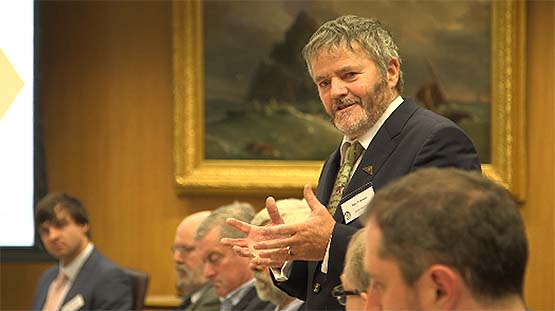 The maritime evangelist……Enda O'Coineen in full flight at this weeks AGM of the Atlantc Youth Trust
The maritime evangelist……Enda O'Coineen in full flight at this weeks AGM of the Atlantc Youth Trust
Ironically, although one of the main lines of thought in the AYT’s thinking is that the ship they’ll provide will be more of a floating multi-discipline schoolship of many projects, both afloat and ashore, rather than a traditional sail training ship, it emerged at the AGM that it was the traditional Tall Ships visit and Parade of Sail in Belfast and on Belfast Lough last July which gave them their greatest boost.
They’d a significant presence there, and thanks to one of the Trust Board Members, they’d the use of a fine big motor vessel aboard which visiting politicos and other heavy hitters could be taken on a sociable yet instructive tour of the harbour and the Tall Ships fleet. For many of these decision makers and opinion formers, it was a transformative experience, turning them into supporters of the Atlantic Youth Trust’s way of thinking.
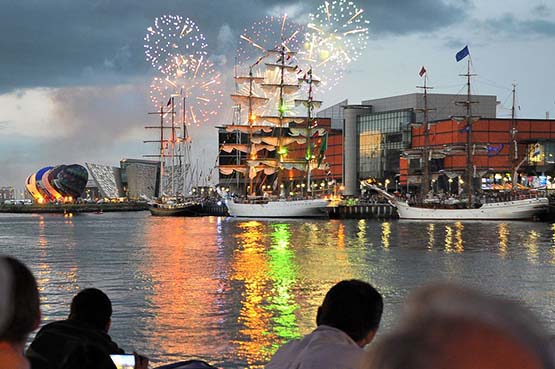
The Tall Ships in Belfast, July 2015
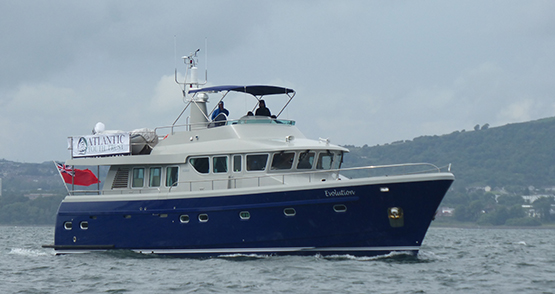
This opened doors north and south, and they rapidly increased their already formidable knowledge of how to work the corridors of power. The meeting on Thursday in Irish Lights was chaired by Peter Cooke from the north, and his affable presence made the running of business very smooth indeed. But as each specialist on the board revealed the progress they’d made during the past year and more in their particular task, it was to realize that here were people who were utterly professional in their approach, yet went at the job with the total enthusiasm of dedicated amateurs.
But what most impressed was the synergy of the high octane talents on the board which, in addition to Lord Glentoran, Enda O Coineen and Peter Cooke, can draw on the talents of people of the calibre of Dr Gerard O’Hare, Roger Courtney, Sean Lemass, David Beattie and John Killeen – with Neil O’Hagan as the key conduit, they’ve turned themselves into a formidable lobbying organisation.
It’s a fact of life in all Irish political administration, and particularly in Dublin, that each separate government department much prefers to function independently within its own little bubble, with nothing whatever to do with any other department while avoiding overlaps if at all possible. This is especially so in the neglected area of maritime activity, which is overseen by several departments, and is further warped by the reality that the government is in Dublin - which is also the biggest port - yet the real scene of the maritime action and the true hotbed of ideas is Cork.
So our shrewd operators in the AYT stood back and concluded that the politician they should most directly target was of course Minister for the Marine (and many other matters) Simon Coveney TD of Cork, but that in Dublin the departments to be wooed were Finance and the Office of the Taoiseach.
With increasing support at official level in the north and enthusiasm from key decision makers in the Republic, things were going grand when the President of the AYT suddenly went off in December 2015 to race single-handed across the Atlantic from the Caribbean to Brittany in his IMOCA 60 Kilcullen Voyager. Enda O’Coineen’s big boat has been very much part of the AYT awareness programme for the past year, taking trainee crews to sea. But this was something else altogether, and it made many supporters of the new training ship ideal distinctly nervous.
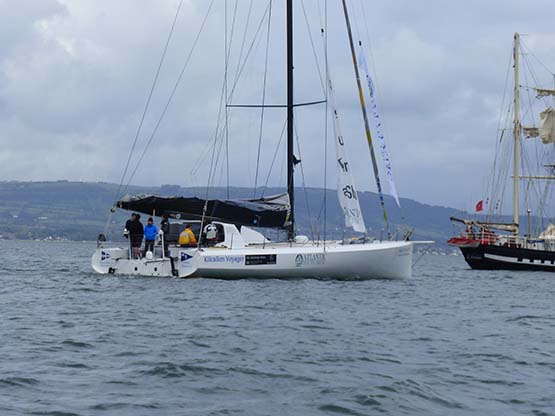
Racing across the Atlantic in as rough a December as anyone could remember may have been a personal challenge, but inevitably it was a high risk venture with which the AYT was inevitably associated, whether it liked it or not. The sailing community in Ireland is small, and nothing can happen in isolation. But to everyone’s enormous relief, not only did the boy do it, but he did it well, sailing across in style and securing a podium place with third at the finish.
This was quietly acknowledged as something which had been on everyone’s mind in a graceful little speech by the Deputy Chairman of the Irish Lights Commissioners congratulating the President on his Transatlantic success. So with everything in place as regards where AYT now stands in relation to both governments, the formal part of the meeting concluded with some commitments as to the way ahead, and the news that the Atlantic Youth Trust’s next public gathering of significance will be in Galway on March 12th, when more precise details of the new ship and the building programme will be revealed.
However, with an ethos in which going the extra mile is part of the DNA, the AYT then laid on a hugely entertaining dinner in the neighbouring Royal Irish YC with fascinating shows by the Gardai Siochana’s Conor O’Byrne, who played a central on-board co-ordination role in rescuing a crewman who had gone overboard in mid-Pacific from the Clipper yacht Derry-Londonderry-Doire, and from Stewart Hosford from Cork, who is CEO of the organisation Five Degrees West whose main project is the designing, building and management of the Imoca 60 boats raced under the Hugo Boss campaign by Alex Thompson.
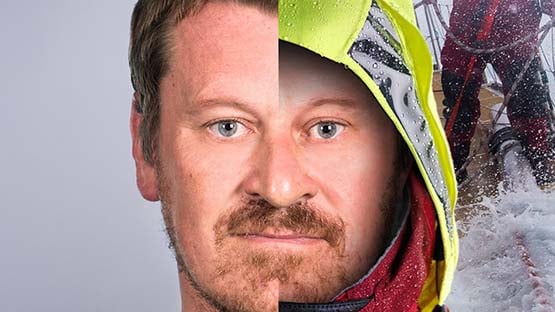 May The Force Be With You – the two faces of the Garda Siochana’s Conor O’Byrne, who gave the AYT and its supporters a fascinating insight into the successful rescue of a crewmember who went overboard from Derry/Londonderry/Doire in mid-Pacific.
May The Force Be With You – the two faces of the Garda Siochana’s Conor O’Byrne, who gave the AYT and its supporters a fascinating insight into the successful rescue of a crewmember who went overboard from Derry/Londonderry/Doire in mid-Pacific.
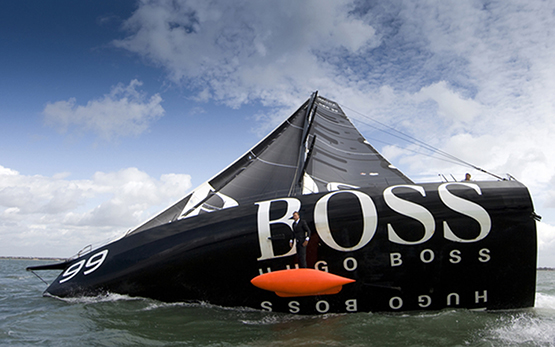 Suits you, Sir…..Alex Thompson on the second Hugo Boss. At Thursday’s meeting, Stewart Hosford of Cork – whose interest in the sea and sailing was inspired by Asgard II – gave the inside story on his job as CEO of the Hugo Boss sailing challenges.
Suits you, Sir…..Alex Thompson on the second Hugo Boss. At Thursday’s meeting, Stewart Hosford of Cork – whose interest in the sea and sailing was inspired by Asgard II – gave the inside story on his job as CEO of the Hugo Boss sailing challenges.
Each compact yet thought-provoking show would have made for a worthy topic on its own in most clubs’ entertainment programme. But it was special to include both on this night of all nights, as each speaker had been enthused in their youth by sailing on Asgard II, and each would do anything to ensure that the upcoming generations get a similar opportunity and inspiration.
It was that kind of night, with the congenial attendance including Seamus McLoughlin and Michael Byrne from Sail Training Ireland, and Oliver Hart whose 70ft schooner Spirit of Oysterhaven continues gallantly to fulfill the role of Ireland’s premier sail training vessel from her base on the Cork coast.
In all, it’s a busy few days for Irish sail training, which is definitely no longer an underground movement. Today, Sail Training Ireland hold their 4th Annual Prize Giving and Programme Launch in the Mansion House in Dublin, looking back on a season in which the number of funded trainees sent on sailing ships abroad and at home came in at just under 300, while in all they arranged berths for more than 500.
The plan for 2016 includes a formal twinning of Dublin and Liverpool for maritime festivals, while on the training front, STI are aiming for a target of 350 funded trainees. And as for Ireland eventually returning to having her own sail training ship, no sooner was Thursday night’s remarkable series of events brought to a close than Neil O’Hagan had to gather his thoughts and head off for New York to meet the Ireland Fund. They are taking a serious and very positive interest in the plans of the Atlantic Youth Trust.

Sail Training Tall Ship Project Included In Stormont Agreement Plans
#TallShips - The Atlantic Youth Trust has hailed its inclusion in the new implementation plan for the Stormont Agreement announced yesterday.
As RTÉ News reports, Northern Ireland's power-sharing administration finally struck a deal yesterday (Tuesday 17 November) after more than two months of negotiations.
And according to the trust's Neil O'Hagan, the sail training initiative is "the only the only independent charitable project included in both this agreement and the Irish Government's Capital Investment Plan.
"This secures our future and most importantly our ability to deliver youth development, peace-building and maritime education voyages for generations to come. In the coming weeks we will be working with both administrations to determine timelines," he added.
The Atlantic Youth Trust has proposed the construction of a new tall ship as a replacement for the Asgard II to bring young people from both sides of the border together for sail training voyages.
O'Hagan said the inclusion of the project "in a historic document such as this does not come easily and would not be possible without the support and guidance of our stakeholders.
"We would like to once again thank everyone involved in getting us to this point and look forward to working with you all over the coming years."
Abandoning Asgard & Supporting The Atlantic Youth Trust
I was doing the RTE television commentary at the start of the 2005 Tall Ships Races from Waterford. Three Irish tall ships led the international fleet ASGARD II, JEANIE JOHNSTON and DUNBRODY, with the State’s vessel, ASGARD, accorded the honour of being the first vessel.
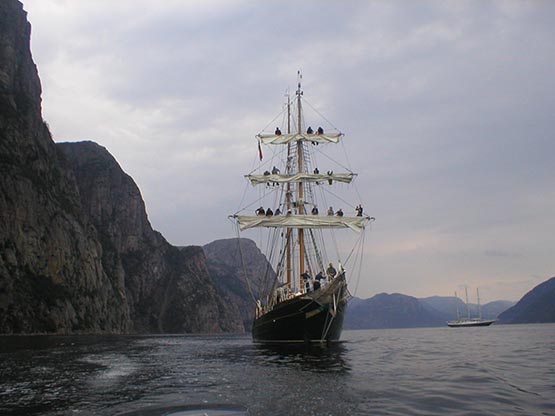
Asgard II in the fjords
Photographs of that occasion recall other television broadcasts I did of Tall Ships Races - the 1997 start from Cork Harbour; the Tall Ships Races in Dublin and Belfast and the return of the Race to Waterford for a second time.
When Neil O’Hagan of the Atlantic Youth Trust told me that the Government had included the Trust in its Capital Development Plan, I thought of those occasions and how the active sailing trio of Irish tall ships had been reduced now to zero.
Neil was enthusiastic: “This is a major breakthrough and the result of over three years research, consultation, and professional advice, not to mention the genuine support of the most senior politicians in Government,” he told me.
I am glad to note that last phrase – genuine support from senior Government politicians, because I remember a time when this was not the case for the national sail training programme.
As I thought about his treatment of ASGARD II I wondered – can a State which abandoned a national sail training vessel after many years of dedicated service, be trusted to deliver on what it has promised towards the concept of a new Tall Ship?
The inclusion in the Government’s planning of the Atlantic Youth Trust’s proposal for a new sail training vessel to facilitate youth development, mentoring, and training on an all-island basis is a milestone for the project, as Neil O’Hagan says. He described it as “the first clear, public commitment from an Irish Government to invest in youth development in the maritime sector and positive in cross-Border relations.
It was a previous Government which abandoned ASGARD to her fate on the seabed off France, but behind every Government is the permanent Civil Service and I wonder has the mindset towards maritime affairs really changed there? As a journalist I also wonder, from long experience of politicians, if a Capital Plan on which implementation will not begin until after the next General Election will be completed and if that is cynicism, it can be traced to Willie O’Dea, then Minister for Defence, who had responsibility in that office for ASGARD when it sank on the eleventh of September, 2008. Here I must state a personal consideration. I heard that news when I arrived in Florida in the USA, on holiday with my wife Kathleen. We were both relieved to learn that our son, Rowan, was not aboard. He was Mate and Deputy Master on ASGARD II for over five years. He was on leave and so, was not involved in the sinking.
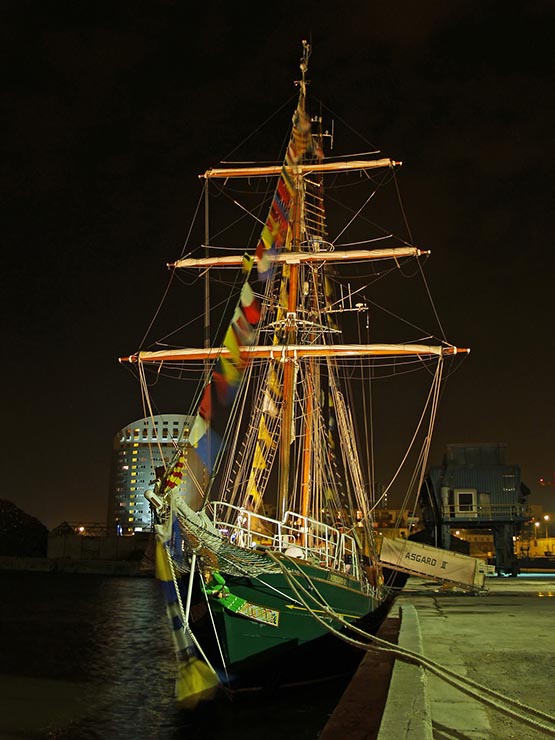
Asgard II all lit up in Limerick – Willie O'Dea's city
I did not have any involvement in the reportage of the sinking, but when Willie O’Dea as Minister responsible equivocated later about initial promises to replace ASGARD and repeatedly turned down offers of replacement vessels, I took up the issue on SEASCAPES which I then presented on RTE Radio. I was careful approaching the issue, but was surprised that no salvage efforts had ever been made. Whatever about the controversy over whether she could be restored to sailing again, it seemed that recovery would be critical to establishing what happened.
When Willie O’Dea later decided that the compensation money of €3.8m, paid by the insurers for the loss of ASGARD should be handed over to general Government funds and not kept for the national sail training programme which was closed down, it was an issue that could not be ignored. I sought an interview that was never granted. I had no reason to conceal the fact that my son had been on the ASGARD crew.
Asgard II Irish national sail training vessel
I believed that the training programme was essential, fundamental, to stimulating youth interest in the sea and that it also provided a wide cultural and educational benefit to young people, something well testified to by those interested in youth development. It also provided opportunities for older sailors, the mix of youth and maturity aboard was mutually beneficial.
Extensive testimonials to this have proved the point, including my own experience at aboard the Jeanie Johnston when she was at the quayside in Newfoundland on her voyage to America and Canada, with thousands visiting her. I was recording a television programme about the voyage when a teenager from Dublin put me in my place. She was amongst a group of boys and girls from North and South of the Border who I asked whether they had had differences between themselves from their backgrounds.
“Mister,” she responded. “There is no 'I' (which I took to refer to being independent) in a crew which is a team that we are and which we have learned to be to sail this boat.”
Message understood!
As Willie O’Dea abandoned ASGARD, repeated attempts were made through his office, the Department and the ASGARD office seeking an interview with Minister Willie, making repeated offers to go anywhere, anytime, to interview him, they were fruitless. I never did get an interview, though Willie is not shy of appearing on the media.
Maybe I wasn’t trusted!
Public appreciation of sail training on Tall Ships is lacking, not helped by general media savagery against the JEANIE JOHNSTON and DUNBRODY over the years, the latter of which has proved itself an essential part of the economic fabric of New Ross, even if not actively sailing, but telling the maritime, historical and emigration story of Ireland.
So what of the future?
There are supporters and detractors of the Atlantic Trust Project and those involved. There was the same about ASGARD and, while there were exceptional people on its board dedicated to sail training, I did wonder at times about some of the appointees and political decisions.
I wish the Atlantic Youth Trust project well and hope for its success.
Following its inclusion in the current Government’s capital programme, Neil O’Hagan said: “We will be working hard to execute our plans with the support of public, private, corporate and philanthropic supporters. While there is still a lot to do, there is an inevitability growing around the project.”
To look at photographs of ASGARD II, to read Winkie Nixon and Eric Healy’s book about ASGARD I and II and see the restored ASGARD I in the National Museum in Dublin, is to realise the huge tradition the new vessel will have to follow.
Also read:
Afloat's Asgard coverage that includes sinking reports and salvage attempts from 2008
Afloat's WM Nixon on:
Tall Ships & Sail Training – Ireland's Atlantic Youth Trust Will Give It A Different Spin
Is a 40m Sail Training Ship Too Much Of a Tall Order For Ireland?
#TallShips - The Atlantic Youth Trust's Neil O'Hagan has described as "a major breakthrough" the sail training initiative's inclusion in the Government's recently announced Capital Plan for the next five years.
"This is the first clear, public commitment from [the] Government that they intend to work with sources in Northern Ireland to deliver our plans [to build a replacement for the tall ship Asgard II]," said O'Hagan. "More importantly, it is a clear commitment by the Government to invest in youth development, the maritime sector, and cross-border relations.
"Our messaging and objectives have carried through as it states 'This proposal involves a new sail training vessel to facilitate youth development, mentoring, and training on an all-island basis.' When combined with the commitment from Northern Ireland to appoint a representative from the Department of Employment and Learning, this shows true all-island support."
The trust's proposals for a new sail training tall ship for Ireland have already attracted the support of a group of influential business people including financier Dermot Desmond,Denis O'Brien and CPL Resources founder Anne Heraty.
#YouthSailing - A once-in-a-lifetime opportunity for young people to sail an Open 60 racing yacht around the Irish coast is now available thanks to MSL Ballsbridge Motors Mercedes-Benz and the Atlantic Youth Trust supporters club.
In total eight places are available for 18–to-24-year-olds to take part in two 'extreme' high-performance coastal voyages on board the Kilkullen Voyager. The boat captain for the voyages will be top Irish solo Figaro helmsman David Kenefick.
The first will see the yacht sail from Dun Laoghaire to Belfast to join the Tall Ships Festival from 29 June to 2 July. The second voyage will leave Belfast on the 5 July and finish in Cork on 11 July to coincide with the Ocean Wealth Conference and SeaFest.
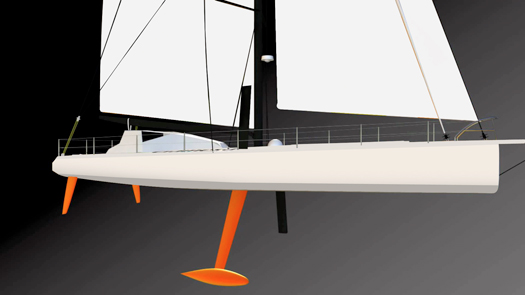
The Kilcullen Voyager is one of the fastest monohull yachts on the water today
Due to the yacht's high performance, sailing experience is required. Conditions on board will be challenging with little to no creature comforts found on other yachts. The benefit is that the Kilcullen Voyager is one of the fastest monohull yachts on the water today.
Speaking about the opportunity, Noel Rabbitte, Mercedes-Benz brand manager at MSL Ballsbridge Motors, said: “We are thrilled to be involved in this exciting, youth development initiative.
"Giving young people this opportunity is comparable to providing a safe environment for young people to drive a Formula 1 car for a weekend with a trained professional in the cockpit.”
No fee is being charged as the yacht has been made available by the Atlantic Youth Trust’s supporters network and the kind support of MSL Mercedes-Benz.
Anyone interested in taking part must submit an expression of interest form (available HERE) by 10am on Friday 26 June.
{youtube}rEbxOEEfeDE{/youtube}
Tall Ships & Sail Training – Ireland's Atlantic Youth Trust Will Give It A Different Spin
#tallships – Rugged sailing in romantic tall ships; the camaraderie of the sea; character development. It's an inspiring combination which has gripped maritime nations for more than a century as sail has given way to more utilitarian sources of power. First there was steam. Then steam in turn was superseded by diesel and even nuclear power. And with each stage, there has been a remorseless drive towards reducing manning levels.
So what on earth is there now to occupy people who, in a former era, might have found a meaningful role in life as crew on board a sailing ship? For with each new development in shipping, we realise ever more clearly that large sailing ships were one of the most labour-intensive objects ever created.
However, we don't need to look to the sea to find areas of human activity where technological development has made human input redundant, and large sectors of the population largely purposeless. It's the general social malaise of our time. So for many years, the majority of maritime countries have found some sort of solution by an artificial return to the labour-intensive demands of sailing ships.
But in an increasingly complex world with ever more sources of distraction and entertainment, does the established model of sail training still work as well as it once did? W M Nixon meets a man who thinks we need a new vision for best using the sea and sailing ships to meet the needs of modern society's complex demands.
Tall Ships and Sail Training........They're evocative terms for most of us. Yet the buzzwords of one generation can surprisingly quickly become the uncool cliches of the next. That said, "Tall Ships" has stood the test of time. It's arguably sacred, with a special inviolable place in the maritime psyche.
So when we see a plump little motor-sailer bustling past with some scraps of cloth set to present an image of harnessing the wind's timeless power, we may be moved to an ironic quoting of Robert Bridges: "Whither, O splendid ship......" But somehow, citing Masefield's "a tall ship and a star to steer her by" would seem to be beyond the bounds of even the worst possible taste.
There's a simple purity about "Tall Ships". It works at every level. Google it, and you'll find the academics claim that it became official with its use by John Masefield in 1902 and Joseph Conrad in 1903, though Henry David Thoreau used it much earlier in 1849. But Conrad being the benchmark of most things maritime in academia, 1903 seems to be set in stone.

We all know what is meant by a true Tall Ship, but as these rig profiles indicate, the proliferation of sail training programmes has led to an all-inclusive approach
Yet at the vernacular level, it has been there much longer than any of them. There's a bit of maritime meteorological lore which our academics would probably dismiss as vulgar doggerel, but I've found it still moves me. When far at sea, with the underlying swell increasingly in evidence and the weather conditions which it describes clearly developing overhead, inevitably you'd remember this little couplet:
"Mackerel sky and mare's tails,
Make Tall Ships carry low sails".
It's not Yeats. But when you're on a formerly blue sea now turning grey and far from anywhere in a 25-footer, it's a little thought which can still make the hairs stand up on the back of your neck. And it's that mention of "Tall Ships" which gives it the added resonance. So things stand well with the phrase "Tall Ships". But what's the word on the continuing viability of "Sail Training"?
"I'm fed up with the constant use of the term "Sail Training". It's bandied about so much it has become meaningless. And always talking about "Sail Training" limits the scope of what we're trying to do. If we could find some useful phrase to replace "Sail Training", but something which is also more visionary than the very pedestrian "Youth Development" which is sometimes replacing it, then maybe we could go a long way to capture the imagination both of our potential supporters, and of the young people we hope will want to come aboard the ship".
The speaker is Neil O'Hagan, busy Executive Director of the Atlantic Youth Trust, which is actively developing ways and means of building a 40 metre sailing ship which will serve all Ireland in a wide variety of functions. And as he has immersed himself in this challenging project when he is clearly a very able person who could name his price in many roles in high-paying large corporations, it behoves us to pay attention.
We have been skirting the AYT and its project several times here recently. But as we gradually emerge from the recession and see what is still standing, for some reason with every passing week we find it ever more disturbing that the Irish Sail Training Brigantine 84ft Asgard II was lost nearly seven years ago by foundering, and the Northern Ireland Ocean Youth Trust's 60ft ketch Lord Rank was lost after striking a rock five years ago.
Far from being swept under the carpet, it's a double whammy which has to be faced and dealt with as 2015 rolls on with the biggest Tall Ships assembly ever seen in Ireland coming to Belfast, and not an Irish Tall Ship worthy of the name to represent us.

The popular image of Tall Ships is a crowded port with a fun-filled crowd...............
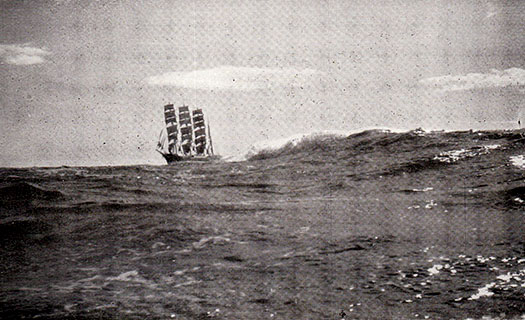
.....yet for many old salts, the true image is the lone ship at sea, going about her business. This photo of a four-masted barque was taken from a small cruising boat in the 1930s
But an ideas-laden shooting of the breeze with O'Hagan soon shows that we're going to have to learn to think a long way out of the box before we begin to meet the demanding expectations of this man and his board of trustees and directors, and the much-anticipated presence of the Tall Ships in Belfast is only a trigger to help activate a much more complex vision. Neil O'Hagan hopes not only to be instrumental in the creation of a new Irish sailing ship, but he also hopes to change the way in which we perceive such a vessel, and our expectations of the way she will be used.
In our initial blog on this back on January 17th, we thought we were making a tellingly adverse point in suggesting that the barquentine Spirit of New Zealand - which the AYT reckons will provide the best model for the development of their project – is not so much a sail training tall ship as we know it, but rather, with her large complement of 40 "trainees", she's more of a floating schoolship which happens to set sails.
Far from being blown out of the water by this "damning" criticism which I and others had voiced, O'Hagan was delighted that we'd lit upon this aspect of the plan. "Old-fashioned sail training has had its day" he says. "When education authorities and social service bodies and welfare funds and philanthropic organisations are looking for some way to provide interesting, satisfying and ultimately long-term-beneficial experiences for young people of all backgrounds and varying states of mental health including the very happily normal, they expect a much broader curriculum than is provided by the traditional sail training model".
"And come to that, so do the young people themselves. If sailing is genuinely their great leisure interest, they'll be into it already at a personal level among like-minded friends. But if they're more typical young people of today, they'll have a wide range of interests, and during the ten day cruises which we hope to make the backbone of the new ship's programme, the sailing will only be part of it."
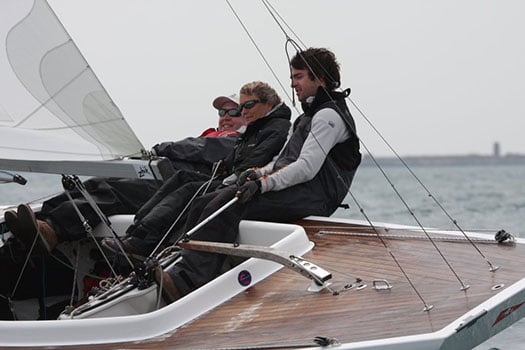
Away from the day job - Neil O'Hagan helming a Dragon
Its not that O'Hagan is anti-sailing. Far from it – he has been seen in the thick of things in the midst of the International Dragon Class in recent years. But a good liberal education with time in the Smurfit Business School in UCD and extensive family links all along Ireland's eastern seaboard north and south, plus direct business experience in both Dublin and Belfast, give him a breadth of vision to provide the AYT with a real sense of purpose.
The Atlantic Youth Trust has been quietly building itself since it emerged from a representative workshop researching the building of a sailing ship for Ireland, held in Dublin Port in the Spring of 2011. From that, a Steering Group of Lord Glentoran and Dr Gerald O'Hare from the north, and Enda O'Coineen and David Beattie from the south – all of whom had worked together before on other north-south youth sailing projects – was set up, and they commissioned a professional consultancy group – CHL Consulting of Dun Laoghaire – to work with them in producing a Vision & Business Plan, which eventually ran to 96 detailed pages.
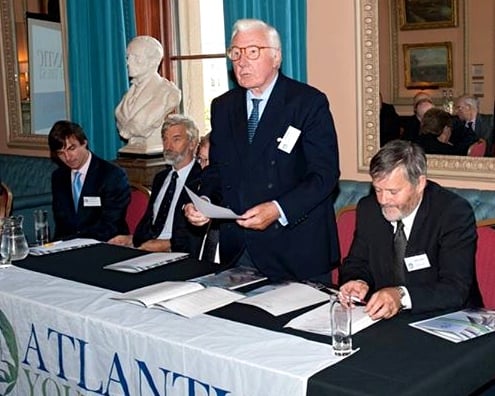
The Chairman Lord Glentoran (Gold Medallist at the 1965 Winter Olympics) at the AGM of the Atlantic Youth Trust with Executive Director Neil O'Hagan (left), Sean Lemass and Director Enda O'Coineen (right)
In due course, the Atlantic Youth Trust emerged with Olympic Gold Medal veteran Lord Glentoran as Chairman. And with Neil O'Hagan as Executive Director, the show was on the road with the detailed worldwide investigation of 25 successful educational schemes involving sailing ships - note we've dropped that "sail training" tag already. And in New Zealand they found something that was really new, something that fell in with their view that the double loss of the Asgard II and the Lord Rank provided an opportunity for a truly fresh look what a national sailing ship might be and do.
It's an extraordinary place, New Zealand - particularly from a maritime point of view. Far from seeing their isolation as a drawback, they use it as an advantage for fresh thinking. And they don't cling to time-hallowed ways brought over from "the old country". On the contrary, being in a new country is seen almost as an imperative for trying new ways and ideas, hence they're at the sharp end of top events like the America's Cup.
And as they were far from the fleets of established tall ships in Europe and America, with the Spirit of New Zealand they had to develop new ways of using a vessel which would spend much of her time cruising their own extensive and very varied coastline on her own, distant from the Tall Ship sailfests which are such a feature of the programme in the more compact and crowded parts of the world.

Spirit of New Zealand is barquentine-rigged
Thus by geographic necessity. New Zealand is ahead of the curve in developing ways of contemporary validity in the use of large sailing ships. We all hear of what a marvellous party the Tall Ships will activate in Belfast, just as they've done before in Dublin, Cork and Waterford. But hold hard just a moment. Isn't sail training aimed at young people mostly between the ages of 15 and 25? Surely their central involvement in vast open air quayside parties - with the inevitable underage alcohol intake possibilities – is totally at variance with the healthy idealism of the concept?
For sure, the organisers of modern Tall Ships Festivals go to enormous effort to ensure that they're genuinely family-friendly events. But the ancient traditions of sailors in port can be difficult to escape. So when you've a proposed programme which is essentially based on recruitment through continuing contact with secondary schools and similar age cohorts – as is the case with the Atlantic Youth Trust project – then it becomes increasingly desirable to have a ship which is large enough to be self-sufficient, with a viable way of onboard life built around large shared areas, such that the traditional waterfront-oriented harbour visits will no longer be such an important part of the cruise programme.

Splendid isolation. Spirit of New Zealand in an anchorage remote even by New Zealand standards
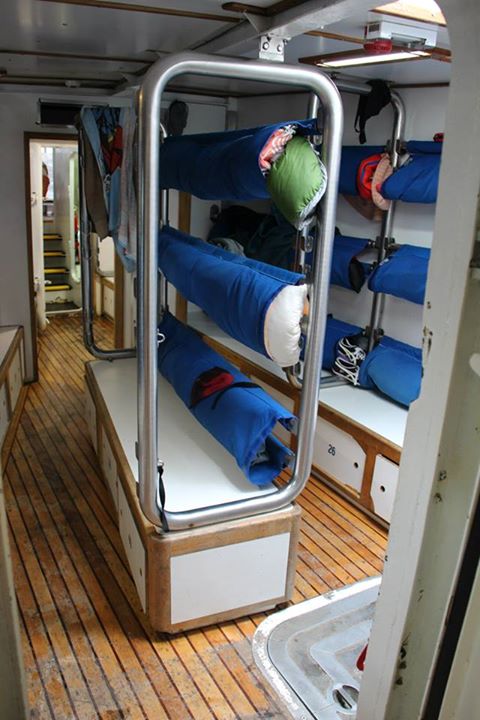
Packing them in....as she carries a crew of 40 trainees, and with space required for extensive communal areas, Spirit of New Zealand's bunks are efficiently planned
Of course the new vessel will take part in Tall Ships Races and Tall Ships Festivals, and of course she'll make the occasional ambassadorial visit, both along the Irish coast and abroad. But with the underlying philosophy of the ship being largely self-sufficient of shoreside distractions other than when they're environmentalist and educational ventures, sometimes with an expeditionary element, then the more gregarious aspects of her yearly routine will be kept well in perspective, and everyone will be the better for it.
As it's essentially a cross-border venture, equal funding from the two governments – each of which it is hoped will put up 30% of the capital expenditure - is anticipated, and with a fresh tranche of Peace Process money on the horizon, the resources are gradually building as people get used to the idea. There has also been much technical background research, and leading naval architects Dykstra of The Netherlands are on the case with an impressive scenario, for as Trustee and Director David Beattie has put it, this one isn't going to be cobbled together, it's going to be a "best in class project".
As the planned use of the vessel is essentially civilian, she will be Ireland's sailing ship without being the national sailing ship. There's more than a slight difference to the Asgard situation. In many other countries, the most impressive tall ships are part of the naval service, but in Ireland we have a Naval Service sailing vessel already, she is the ketch Creidne which was the national sail training vessel between the decommissioning of the first Asgard in 1974 and the commissioning of Asgard II in 1981. In recent years, she has had a major refit and is now actively sailed, but as Ireland's Naval Service is so essentially Cork-based, the Creidne is very much part of the scene in Cork Harbour and the Naval Base at Haulbowline.
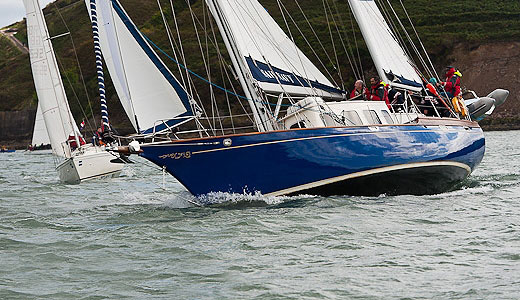
The Naval Service have Creidne for sail training purposes for their own personnel. Photo: Bob Bateman
In fact, although the Atlantic Youth Trust does have a Cork element to it, and advisers include several leading figures in the Cork marine industry, the reality is that it is first and foremost a cross-border enterprise between offices in Dublin and Belfast.
This means that Cork – which is the true capital of maritime development in Ireland, and I mean that in all seriousness – is an associate port to the Atlantic Youth Trust project, rather than a central pillar of it. But I don't think the people of Cork would wish to have it any other way. When I was in the southern capital for the fund-raiser for the new National 18 class development a month or so ago, Class President Dom Long kicked off proceedings by explaining how it was the Corkonian sense of independence which had inspired the mighty leap in National 18 design. He did this by showing a map which neatly illustrated the Cork sailor's view of Ireland.

The Cork sailor's view of Ireland
It says everything. But I don't think the Atlantic Youth Trust should lose any sleep over the fact that they might be seen as being on a Dublin-Belfast axis from which Cork is as usual going its own sweet way. 'Twas ever thus. And anyway, in the end the Corkmen will probably provide many of the officers for the proposed new vessel to which we wish, on this fine Easter Saturday morning, the very fairest of fair winds.
#tallship – With St Patrick's Day almost upon us, the westward trek across the Atlantic in search of American benevolence and funding for worthy objectives can become a very crowded pilgrimage. Among those looking for meaningful support for their pet projects, there will likely be proponents of some sort of new Tall Ship to replace the much-mourned brigantine Asgard II, and the ketch Lord Rank, both of which foundered in 2008 to leave Ireland - north and south alike - bereft of national sail training vessels.
Since then, there have been re-groupings of those who support the admirable concept of sail training for young people. In all, there may be as many as five different bodies on the island of Ireland which now provide access to the international programme. Coiste an Asgard itself was wound up in 2011, but it was immediately re-born as the Dublin-headquartered Sail Training Ireland, the national authority which carries the imprimatur of Sail Training International, the global body which co-ordinates and regulates all sail training.
The other main organisation, often functioning in tandem with Sail Training Ireland, is the Atlantic Youth Trust. It has offices in both Dun Laoghaire and Belfast, and has as its primary objective the construction and commissioning – for all Ireland – of a Class A 40-metre three-masted barquentine. WM Nixon continues with the story.
When we carried a history and analysis of Ireland's involvement with the International Tall Ship and Sail Training movement on this site on January 17th, the immediate response was formidable, and in favour. It continues to register hits at a rate which shows that the maritime community in Ireland has a real wish to see our own proper tall ship.
To achieve this ambition, in terms of having a clearly outlined plan the Atlantic Youth Trust is way ahead. With leading personnel from many parts of Ireland on its high-powered board of Trustees and Directors, the concept - originally inspired by Enda O'Coineen and John Killeen of Galway – is already becoming very complete.
Executive Director Neil O'Hagan and other have researched globally in order to analyse the success of more than two dozen national sail training schemes, and they have concluded that the best model to learn from is the Spirit of Adventure Trust in New Zealand, which functions through training based around the barquentine Spirit of New Zealand, which at 45.2 metres in "sparred length" is steel built registering at 184 gross tons, and carries 40 trainees.
The funding concept on the capital outlay for building the new ship for Ireland will ultimately rely on a total of €15 million being put up jointly by the two governments in the interests of inter-community and cross-border co-operation. Although the current turmoil in the Northern Ireland political administration might temporarily impair the onward progress of the plan, it seems to have a certain inevitable momentum, and highly-regarded Netherlands-based Dykstra Naval Architects have been retained on the project, as have their associates at Damen Shipyards, who may supply the vessel in flatpack form for final construction in Ireland.
As to running costs, the AYT point out that it will come out of current spending, as the vessel by nature of its work will be able to tap into government funds for social welfare and other youth schemes.
Faced with such a juggernaut of ideas, energy, contacts at top government level, and sheer enthusiasm, it seems churlish to question the validity of what is, after all is said and done, a magnificent project. But there are many in Irish sailing in general and sail training in particular who are concerned about the thinking on which it is all based.
To begin with, while we all admire the maritime spirit of New Zealand, does it make sense to draw conclusions for Ireland from a successful scheme in what is essentially a very isolated island nation? Ireland may be an island nation, but it's clearly wide of the mark to describe us as isolated, and this is reflected in the pattern of tall ships visit. If just six tall ships turn up at one port in New Zealand, it's regarded as a major event. But if less than sixty tall ships turn up at this year's Tall Ships Festival in Belfast at the beginning of July, then it will be regarded as a non-event.
In other words, Spirit of New Zealand usually functions in relative isolation, so it is not sail training as we know it in Europe. In fact, she is more of a floating school cum boot camp which happens to set sails, and in order to keep her very numerous trainee complement of 40 busy, while cruising in New Zealand waters (which she does nearly all the time), she is escorted by a large rib which frequently conveys the trainees ashore for land-bound ventures which sometimes out-balance their sea time.
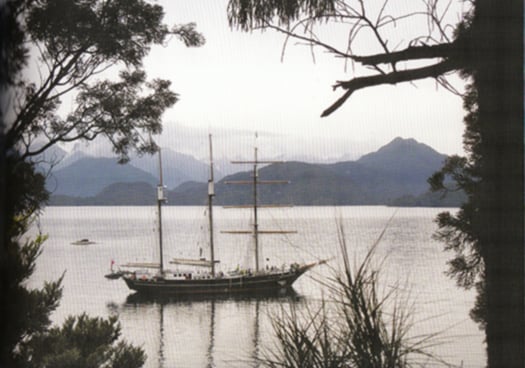
Alone, all alone.....the Spirit of New Zealand in a remote inlet on New Zealand's South Island. With forty trainees and a relatively easily-handled rig, she has a programme whch includes much shoreside activity. Photo courtesy STI
It's a very attractive programme in the New Zealand context, as they have many remote coastal areas which are virtually uninhabited and ripe for shore adventures which will not conflict with the rights of local inhabitants. But in Ireland and much of Europe such a programme would immediately meet problems, and for Ireland it makes more sense to follow the European pattern which puts an almost total emphasis on voyaging and sail training races.
Were a heavily-crewed vessel such as Spirit of New Zealand to do the European programme, there simply wouldn't be enough work for the 20 trainees on each watch to keep them happily occupied for long periods. Ideally, trainee tall ships are extremely labour-intensive for all hands, and in Europe that's the way it is done, but it needs what amounts to individual attention for each trainee.
So it's difficult to escape the conclusion that one reason for the attraction of the New Zealand scheme for the Atlantic Youth Trust is that it wins out in the numbers game. Forty young people taken out of troubled and aimless environments ashore, and sent away together on a voyage, is an impressive amount of social problems temporarily sorted in one fell swoop.
But will it be as behaviourally beneficial, in the long term, as it would be for a smaller number of people on a smaller and busier vessel? It will vary from case to case, but generally you'd reckon that the smaller more personal crew setup, with each trainee more directly involved in the sailing of the ship, would produce better results, while always remember that having as much square rig as possible is central to the concept.
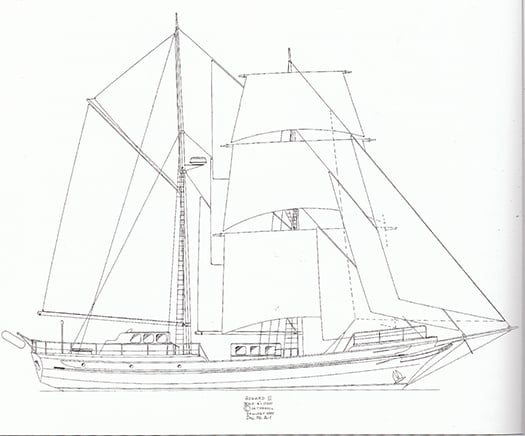
A timeless design which remains a very viable proposition for an easily managed ship which keeps her crew busy. Jack Tyrell's lines for Asgard II would lend themselves to construction in steel or even aluminium.
Ideally, to see Ireland's Tall Ship-owning reputation restored, many of us would like to see not just one newly-built replica of the 84ft brigantine Asgard II being launched, but three – one each for Cork, Dublin and Belfast. For, at the moment, the main axis of Atlantic Youth Trust activity seems to be between Dublin and Belfast. Yet as last weekend's National Annual Sailing Awards ceremony in Dublin so clearly underlined, Cork is really where it's at in terms of maritime development, and the lack of a significant Cork element seems to be a weakness of the AYT scheme.
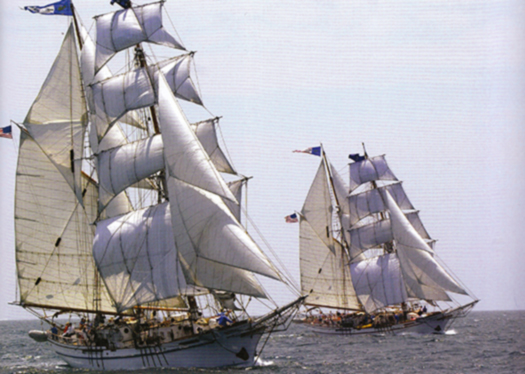
Might this be the way forward? One of our suggestions today is that Ireland really needs three Asgard IIs, based in Cork, Dublin and Belfast. We get an idea of how it might look with the two sister-ship American brigantines Exy Johnson and Irving Johnson, which are based in Los Angeles in California, where they were built in 2002.
Nevertheless, it says much for the dedication and energy of those promoting the Atlantic Youth Trust that we have the luxury of debating the validity of their plans, which have been so thoroughly developed. We may disagree with their conclusion, but it's not total disagreement – an Irish version of Spirit of New Zealand would be a very emphatic improvement on our present ship-less state, which is too much of a reflection of an ancient and negative mind-set.
Every time you see the Tall Ships gather and see how maritime countries of population comparable to Ireland, such as Norway, Denmark and Portugal, can send forth spectacularly handsome Tall Ships, it becomes a painful reminder of how the new Irish Free State increasingly turned its back on the sea.
The fact was admitted by Minister for the Marine Simon Coveney at last week's National Sailing Awards Ceremony in a speech which hinted at some very significant developments in the Irish maritime sphere in the near future.
But really, what Minister Coveney was talking about is that it is time and more for us to grow up in our attitude to the sea. When the Free State was struggling into being in 1922, the popular view was that British power was synonymous with sea power. So if you were against the sea and seafaring in all its manifestations, then you were demonstrating the purity of your patriotism through adopting what was essentially if subconsciously an anti-British stance. Childish perhaps. But we all know that's the way it was.
So despite the flurry of maritime enthusiasm which was engendered by national emergency during World War II to inspire the creation of Irish Shipping and the Maritime Inscription, what this meant was that when the underlying attitude genuinely began to change in the 1950s, a positive attitude towards the sea wasn't being built upwards from Ground Zero. It was being built from Ground Minus Thirty – the number of years that an anti-maritime attitude had been the unstated yet very real official policy.
Thus there was a period when Irish maritime enthusiasm had to be kept going almost as a secret cult, and I'd an odd reminder of this some weeks back at the annual Awards Ceremony of Sail Training Ireland. The Patron of STI is President Higgins, and the event was held – for the second year running – in the Mansion House in Dublin. Yet the very fact of the identity of their Patron, and of their event being staged in the Mansion House in the presence of Lord Mayor Christy Burke, provided such pleasure and pride for everyone in the gathering that it was a forceful reminder that, not so very long ago, seafaring was very much the poor relation in Ireland, and there were those in authority who would have happily air-brushed it out of the national picture entirely, leaving it to foreign crews to undertake the rough trades of the sea.
But thanks to those former members of Coiste an Asgard who refused to give up the vision of sail training for Ireland, even as the onset of economic Armageddon from 2008 to 2011 made any prospect of a new Asgard II a very distant vision as the government chucked the €3.8 million insurance payout into the bottomless pit of national debut, Sail Training Ireland arose like a Phoenix and set in place sail training bursaries for places on foreign tall ships, using international contacts built up during the 27 successful Asgard II years to ensure that Ireland could re-build our position at the heart of the movement.
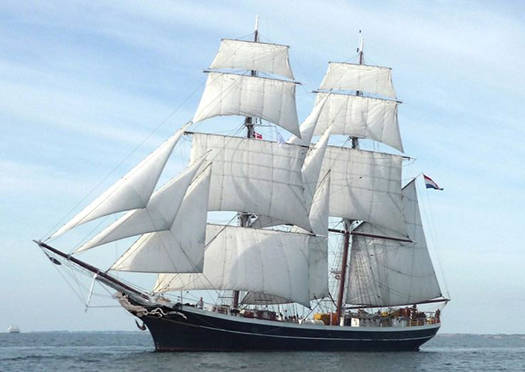
She keeps them busy....the Dutch brig Morgenster is superbly labour-intensive in the best sail training traditions. Photo courtesy STI
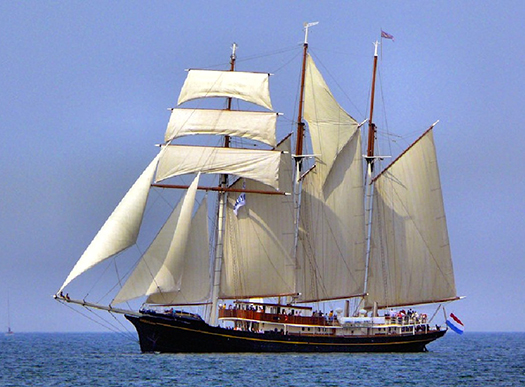
Gulden Leeuw is another of the Dutch Tall Ships which have been taking Irish trainees to sea on Sail Training International programmes. Photo: Courtesy STI
The thriving tall ships scene in the Netherlands – which has become a focal point for sail training and the Tall Ships industry for all Europe – proved the most fruitful placement area, with most Irish trainees being positioned aboard the very handsome 48 m (sparred length) brig Morgenster, which has become a familiar sight in Irish ports. Another ship well used is the three-masted topsail schooner Gulden Leeuw, a long slim craft as she is 70 m in sparred length, while that noted poster girl of Tall Ships sailing, the 56 metre three masted Dutch barque Europa, also carried Irish crew from time to time.
However, while placements on such vessels work very well, the hankering for an Irish sail training flagship is always there, and fortunately in recent years Oliver Hart's 70ft training schooner Spirit of Oysterhaven has been punching way above her weight in filling the role in gallant style with a varied programme on the Irish coast.
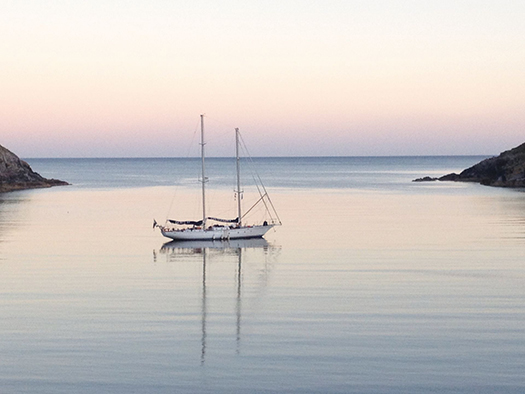
Spirit of Oysterhaven in South Harbour, Cape Clear Photo: Oliver Hart
This and much more was reflected in the Sail Training Ireland Awards Ceremony in the Mansion House, a goodly gathering which was representative not just of every possible aspect of sail training at home and abroad, but also of Irish ports which are increasingly interested in an activity which brings their ancient waterfronts vividly to life. And the progress of various ship projects was spoken for by everything from complete vessels such as the Basque Spanish schooner Atyla represented by Rodrigo de la Serna, through vessels in the making as personified by our own ketch Ilen. She has since seen her final new plank knocked ceremonially into place at Oldcourt in Baltimore, but here's an evocative video Gary MacMahon left with us of the creative planking process under way. And present too was Neil O'Hagan of Atlantic Youth Trust, whose organisation deservedly received recognition for their pioneering work towards a completely new ship.
{youtube}ZLT3D8TBbwk{/youtube}
The main awards presented in the Mansion House by STI Chairman Seamus McLoughlin, who is former Head of Operations for Dublin Port, were:
1. Trainee of the year: Andrew Crowley
2. Special Contribution Award: Turlough Kennedy
3. Special Achievement Award: Fiona Armson
4. Perpetual Asgard Award: For an outstanding contribution to, or achievement in Sail Training by an individual or group: Atlantic Youth Trust / Foroige Group of Trainees
5. Watch-leader of the Year: Sara Mason
6. Volunteer of the year: Jonathan O'Brien
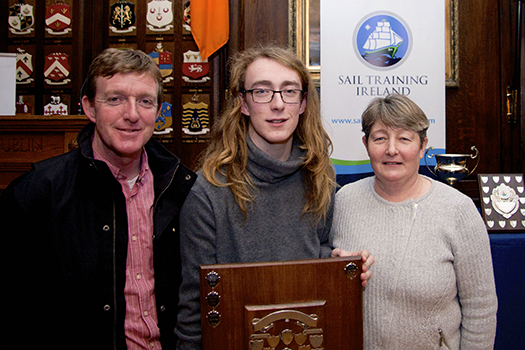
Trainee of the Year Andrew Crowley with his parents in the Mansion House
Trainee of the Year Award: Andrew Crowley
Andrew is Club Captain of the Spirit of Oysterhaven Trust. During 2014, he was instrumental in helping to organise the Club's sailing trips aboard Spirit of Oysterhaven with a special emphasis on providing opportunities for young people with disability. He helped to organise the Club's Youth in Action programme, and crewed aboard Spirit during the Irish Cruising Club's sponsored Anniversary voyage from Glandore to Glengariff with a crew of eight trainees, including several with disability. During the summer Andrew was a vital member of a short-handed crew delivering Spirit from Oysterhaven to Glandore during which he proved himself an outstanding active crew member.
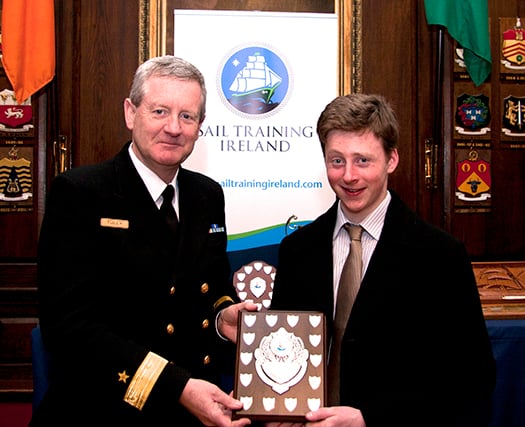
Commodore Hugh Tully, Flag Officer Commanding Naval Service, with Turlough Kennedy, who received the Special Contribution Award
Special Contribution Award: Turlough Kennedy
This year's special contribution award goes to Turlough Kennedy from the lakeside port of Scarriff in County Clare for the outstanding role he filled on the Dutch tall ship Morgenster.
To quote Michael Byrne, Director of Sail Training Ireland: "This contribution was not only recognised by us. On completion of last year's voyage Turlough - despite his limited sea going experience - was offered a crew member's berth on board the ship by the Captain. While he was not in a position last year to take up this offer for the remainder of the 2014 season, in 2015 we are delighted that Turlough will be sailing as voluntary crew on board the Morgenster. The following is a short note from the ship's Captain, Harry Muter: "Turlough sailed with us last year and he was very good good both in the sailing department as in the social processes. For his age he was surprisingly adult, patient and emphatic. And then the music, it coloured this voyage, and Turlough played a role with his complicated bagpipe and improvisation talent. Looking forward to sail with him again." " (There are no prizes for guessing that "complicated bagpipes" are Uileann Pipes).
Special Achievement Award: Fiona Armson
The special achievement award this year went to Fiona Armson for the tenacity and determination she showed by completing her 14 day voyage. Fiona found some aspects of life at sea a real challenge but despite being given several opportunities by her leaders and the crew to take on a lighter work load Fiona refused to leave her watch and pushed on.
Fiona completed her voyage having never missed a single watch or duty and, in a way that would put a smile on any sailor's face, she sailed the Gulden Leeuw into her home port of Bangor.
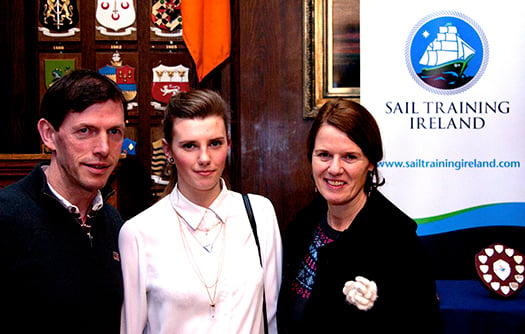
Special Achievement Award Winner Fiona Armson with her parents
Perpetual Asgard Award
Awarded to a group of four Foroige Trainees: Michael Collins, Dean Mc Keon, Brandon McDonagh, and Daniel O'Halloran,
In March 2014, four young people from Ballybane in Galway set out on a remarkable adventure, travelling half way around the world to experience the Spirit of Adventure's 10-Day Youth Development Voyage in New Zealand. Three youth workers accompanied the group for the three week trip, and one of them, Pearse O'Toole, was at the Mansion House with them. The trip was funded by a private donation and managed by the Atlantic Youth Trust and Foroige.
The group spent 10-days sailing around the magnificent Hauraki Gulf off Auckland on the barquentine Spirit of New Zealand. They adapted very well to their new surroundings as crew members and returned with fresh skills, more confidence than ever, and a new outlook on life and what is possible.
Neil O'Hagan, Executive Director of the Atlantic Youth Trust, followed this award with a presentation about the Peace and Reconciliation Fund-supported Sea-Connections scheme, and then the next award was remarkably appropriate, as it was for the Watch Leader of the Year and it went to Sara Mason for her very successful participation in an EU Youth Exchange Voyage on Gulden Leeuw.
Sara (pronounced saarah) is from the North Island of New Zealand, but now lives and studies in Dublin. She is part of the Shackleton Outdoor Adventure Management Diploma Course in Colaiste Dhulaigh in Coolock. She joined the team of youth leaders which facilitated the main voyage programme of Youth Exchange projects in May-June. As a leader on the Dutch Ship Gulden Leeuw, she cared for and facilitated a group of 40 young adults over a 14 day period. She was an outstanding support to them as a leader, and brought with her a set of skills that are unique to professionals who spend their lives working with people in the outdoor adventure industry. She also has a fantastic energy and enthusiasm and was an inspiration to the trainees and other leaders.
Volunteer of the Year Award - Jonathan O'Brien
Jonathan has become involved in a multitude of voluntary activities with Sail Training Ireland in the last year. In 2013 he volunteered as a youth leader for one of STI's youth exchange voyages for 10 days from Belfast to Dublin. In 2014 he was head-leader across youth exchange voyages with a total of 8 leaders, with at times up to 100 trainees across three ships seeking his support.
Having a background in both outdoor education and in social care, Jonathan has an exceptional set of skills that lend themselves very well to the role of leader on a tall ship, and he has now found himself "volunteered" for a position on STI's sub-committee for trainee programmes. During 2014, he also spent time on a number of ships across Europe, while somehow also fitting in a spell serving as First Mate on the Spirit of Oysterhaven. He is helping to develop on-board programmes for a number of STI's funded voyage schemes during 2015, and will also train STI's group of twelve youth leaders in April.
So the good work goes on, but the more of it there is, the more it become apparent that Ireland needs her own tall ship, and the sooner the better. A programme of international placement may work very well for those in the know, but for people down the country which are remote from maritime communities, it often takes the stimulus and sense of pride engendered by an Irish ship to make that first move afloat.
It was summed up so well by investigative academic and journalist Dr Elaine Byrne in our story about the Tall Ships on January 17th that it deserves repeating here. Usually in her line of work, Elaine Byrne takes no prisoners. But the quiet depth of feeling underlying the brief story of how the Byrne family from the deepest rural depths of County Carlow became involved in sail training has a resonance for us all today:
"I'm the oldest of seven children from a farming family on the Carlow/Wicklow border, where the household income is augmented with a funeral undertaking business attached to a pub in which I might still work on visits home. Our background is just about as far as it's possible to be from Ireland's maritime community. Yet thanks to Asgard II, I was able to take a step into the unknown world of the high seas as a trainee on board, and liked it so much that over the years I spent two months in all on board, graduating through the Watch Leader scheme and sailing in the Tall Ships programmes of races and cruises-in-company.
Down in the depths of the country, my new experiences changed the family's perceptions of seafaring. Four of my siblings then had the opportunity to sail on Asgard II. If it were not for Asgard II, my family would never have had the chance to sail, as we did not live near the sea, nor had the financial resources to do so. The Asgard II played a large role in our family life as it became a Rite of Passage to sail on board her. My two youngest siblings did not sail on Asgard II because she sank, which they much regret.
Apart from the discipline of sailing and the adventure of new experiences and countries, the Asgard II brought people of different social class and background together. There are few experiences which can achieve so much during the formative years of young adulthood".
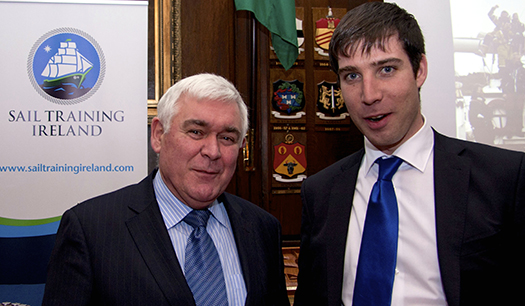
Seamus McLoughlin, Chairman of Sail Training Ireland, with Michael Byrne, Director.

Carolanna Foley, awarded a Drogheda Port Sail Training Bursary, with Seamus McLoughlin (left) and Commodore Hugh Tully
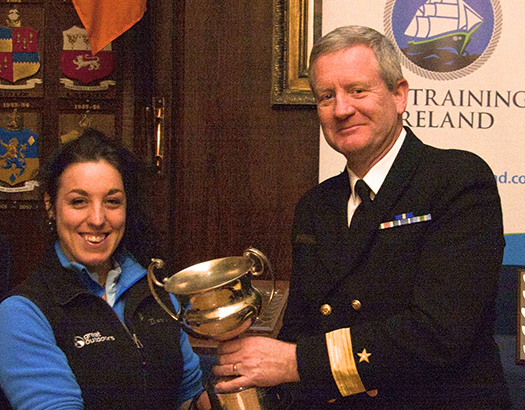
Sara Mason, Watch Leader of the Year, with Commodore Hugh Tully

Jonathan O'Brien (left) Volunteer of the Year, with Oliver Hart
- Sagres
- Tall ship
- Coiste an Asgard
- Atlantic Youth Trust
- barquentine
- Sail Training Ireland
- Sail Training International
- John Killeen
- Enda O'Coineen
- Neil O'Hagan
- Dykstra
- Damen Shipyard
- sailing
- Simon Coveney
- Lord Mayor
- Phoenix
- Spirit of Oysterhaven
- Europa
- Morgenster
- Gulden Leeuw
- Basque Spanish schooner Atyla
- Ilen
- Elaine Byrne
- Oysterhaven
- Mansion House
- Christy Burke
- World War II



























